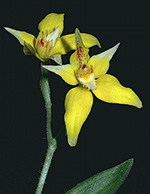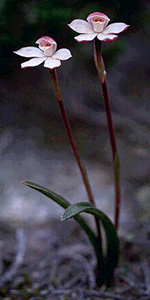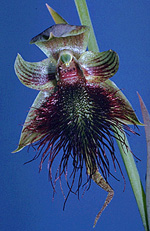 |
This is one of the largest, most widespread and most diverse, yet most easily recognised families of flowering plants in the world. In Australia, many species are found growing as epiphytes in tropical rainforests, while many terrestrial species grow in temperate heaths and grasslands especially on poor, sandy soils. A few are alpine. None grow in saline habitats or in the arid interior.
Characteristic features of the family Orchidaceae in Australia include: - perennial herbs, usually with corms or root-tubers when terrestrial or robust rhizomes if epiphytic
- leaves very variable; sometimes only one leaf per plant, usually relatively narrow and strap-like with parallel veins, but sometimes ovate to circular or heart-shaped, and occasionally fleshy
- flowers usually showy, mostly prominently zygomorphic, characteristically with 6 perianth parts of which one is specialised into a labellum usually very different in shape, size or colour from the remainder
- anthers nearly always fused with the style to form a specialised column, with the pollen shed in bundles (pollinia)
- ovary inferior, developing into a capsule that splits longitudinally to release the many fine, dust-like seeds
Description
Evergreen or deciduous herbaceous perennials, either vines climbing by root suckers or scrambling or terrestrial herbs or epiphytes. Perennating by corms, rhizomes or root-tubers. Vegetative reproduction absent or by corms, root-tubers, rhizomes or stolons. Stems succulent or not; nodes conspicuously swollen or not; internodes solid or hollow, terete, strongly flattened or distinctly angular. Chlorophyll present or absent (then the whole plant white, pink, yellowish or brownish). Plants partially or totally parasitic (on fungi). Internal secretions not obvious. Plants glabrous, or with stellate, clavate, capitate or vesicular glandular or non-glandular, unicellular or multiseriate hairs. Leaves well developed, or much reduced (i.e. to scales, etc) or entirely absent, alternate and spiral, or distichous, or apparently whorled, cauline, all or mostly basal, or both basal and cauline, petiolate, subsessile or sessile; pulvinae present or absent. Stipule-like lobes absent. Lamina simple, symmetric or conspicuously asymmetric, sometimes palmatifid or palmatisect, filiform, acicular, subulate, linear, lanceolate, ovate, elliptic, oblanceolate, ovate, oblong or orbicular; base cuneate, attenuate, rounded, cordate or oblique; margins entire, crenate, dentate, serrate or sinuate, ±flat, revolute, recurved, involute or incurved; one-veined, or the venation pinnate, palmate or parallel, with the midrib conspicuous or inconspicuous, and the tertiary venation reticulate or not; surfaces punctate or not punctate; herbaceous, leathery, succulent or papery. Leaf ligule absent. All the flowers bisexual. Inflorescences terminal, axillary or leaf opposed, consisting of capitula, spikes, racemes, panicles or solitary flowers. Bracts and bracteoles present or absent. Pollination by insects, birds or water. Flowers odourless, fragrant or malodorous, sessile or stalked. Floral disc present or absent; nectaries present on the perianth or the carpels. Perianth of 2 dissimilar or similar whorls, rarely apparently 1 only, with 6 segments. Calyx irregular or ± regular; segments free, fused, or some fused and others free, with 3–5 sepals or lobes, or apparently 0, imbricate or valvate in bud, bell-shaped, helmet-shaped, hooded, urn-shaped or tubular, herbaceous; base with or without spurs or pouches, without wings or other appendages. Corolla usually strongly irregular (the median lobe (labellum) often differing markedly from the laterals), or rarely ± regular; segments fused, with apparently 1–3 or 6 lobes, alternating with the sepals or calyx lobes, imbricate in bud, bell-shaped, urn-shaped, helmet-shaped, hooded, funnel-shaped or tubular, 1 or 2-lipped or with a palate, white, cream, yellow, orange, red, pink, magenta, purple, violet, blue, green, grey, brown or black, without contrasting markings, or streaked, spotted, etc, membranous; claws present or absent; lobes ±entire, or notched, emarginate, bifid, bilobed, trifid, trilobed or more divided, or ciliate or fimbriate; base without appendages, or rarely with spurs. Fertile stamens 1–2, opposite to or not clearly correlated with the sepals or calyx lobes, free of the corolla, partly or wholly fused with style to form a column (gynostemium) or rarely almost free from it. Staminodes present or absent. Staminal filaments rarely present. Anthers 1 (usually sessile) or rarely 2, opening irregularly, 2- or 4-celled, with 4 (–8) pollinia,. Ovary inferior. Carpels (1–) 3, fused; ovary with 1 or 3 locules. Style single and unbranched, or absent with the stigma ±sessile on the ovary. Ovules numerous per locule, stalked; placentation parietal or rarely axile. Fruit a dry, rarely fleshy, dehiscent or rarely indehiscent septicidal or loculicidal capsule or rarely a berry; the perianth on the maturing fruit deciduous, or rotting or liquefying, or dry and persistent, or growing larger. Disseminule macro-surface featureless or winged; micro-surface ±reticulate, white, yellow, brown or black, dull. Seeds often very numerous per fruit, dust-like. Aril absent. Cotyledons 0. Embryo round or shapeless.
(Note: this description has been generated from the coded data compiled for the key. Any errors in the key data will be reflected in the descriptions.)
A treatment of the family Orchidaceae has not yet been published in the Flora of Australia. It will appear in Volume 47.
Australian genera of Orchidaceae (as recognised for the Flora of Australia)
* = all species introduced
Acianthus
Acriopsis
Adenochilus
Anoectochilus
Aphyllorchis
Apostasia
Arthrochilus
Bromheadia
Bulbophyllum
Burnettia
Cadetia
Caladenia
Calanthe
Caleana
Calochilus
Cheirostylis
Chiloglottis
Chiloschista
Cleisostoma
Corybas
Corymborkis
Cryptostylis
Cyanicula
Cymbidium
Cyrtostylis
Dendrobium
Didymoplexus
Diplocaulobium
Dipodium
Diuris
Drakaea
Drymoanthus
Elythranthera
Epiblema
Epidendrum
Epipogium
Eria
Eriochilus
Eulophia
Flickingeria
Galeola
Gastrodia
Genoplesium
Geodorum
Glossodia
Goodyera
Habenaria
Hetaeria
Leporella
Leptoceras
Liparis
Luisia
Lyperanthus
Malaxis
Micropera
Micpotis
Mobilabium
*Monadenia
Nervilia
Oberonia
Oeceoclades
Orthoceras
Pachystoma
Papillilabium
Paracaleana
Peristeranthus
Peristylus
Phaius
Phalaenopsis
Pholidota
Phreatia
Plectorrhiza
Podochilus
Pomatocalpa
Prasophyllum
Pteroceras
Pterostylis
Rhinerrhiza
Rhizanthella
Rhynchophreatia
Rimacola
Robiquetia
Saccolabiopsis
Sarcochilus
Schistostylus
Schoenorchis
Spathoglottis
Spiculaea
Spiranthes
Taeniophyllum
Tainia
Thelasis
Thelymitra
Thrixspermum
Townsonia
Trachoma
Trichoglottis
Tropidia
Vanda
Vrydagzynea
Zeuxine

|
  |

Bulbophyllum weinthalii (flowering plant)
Photo: M.Fagg © ANBG

Caladenia flava (flowers)
Photo: M.Clements © ANBG

Caladenia lyallii (flowers)
Photo: C.Totterdell © ANBG

Calochilus paludosus (flower)
Photo: M.Clements © ANBG

|

| |